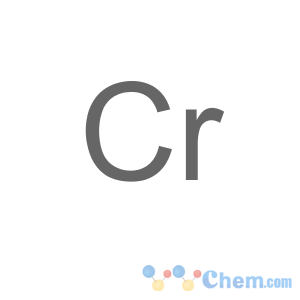Title: Chromium
CAS Registry Number: 7440-47-3
Literature References: Cr; at. wt 51.9961; at. no. 24; valences 1-6. Group VIB (6). Four naturally occurring isotopes: 50 (4.31%); 52 (83.76%); 53 (9.55%); 54 (2.38%). Artificial radioactive isotopes: 45-49; 51; 55-57; longest-lived isotope is 51Cr (T? 27.704 days) prepd by (n,g) reaction from 50Cr. Abundance in earth's crust: 122 ppm. Isoln from
crocoite (PbCrO4): L. N. Vauquelin,
J. Mines 6, ser. 1, 737 (1787);
idem, Ann. 70, 70 (1809). Commercial sources obtained from chrome ore,
chromite (FeO.Cr2O3). Reviews of chromium, its alloys and compds:
ACS Monograph Series no. 132, entitled "Chromium," M. J. Udy, Ed. (Reinhold, New York, 1956)
vol. 1, 433 pp;
vol. 2, 402 pp; C. L. Rollinson, "Chromium, Molybdenum and Tungsten" in
Comprehensive Inorganic Chemistry vol. 3, J. C. Bailar, Jr.
et al., Eds. (Pergamon Press, Oxford, 1973) pp 623-700;
Chemistry of the Elements, N. N. Greenwood, A. Earnshaw, Eds. (Pergamon Press, New York, 1984) pp 1167-1210; J. H. Westbrook in
Kirk-Othmer Encyclopedia of Chemical Technology vol. 6 (Wiley-Interscience, New York, 4th ed., 1993) pp 228-263; B. J. Page, G. W. Loar,
ibid. pp 263-311. Review of biological function of the Cr(III) ion as essential trace element: Mertz,
Physiol. Rev. 49, 163-239 (1969). Review of carcinogenic risk:
IARC Monographs 2, 100-125 (1973);
ibid. 23, 205-323 (1980); of metabolism and toxicity: M. D. Cohen
et al., Crit. Rev. Toxicol. 23, 255-281 (1993); of toxicology and human exposure:
Toxicological Profile for Chromium (PB2000-108022, 2000) 461 pp. Books:
Chromium: Metabolism and Toxicity, D. Burrows, Ed. (CRC Press, Boca Raton, 1983) 172 pp;
Chromium in the Natural and Human Environments, J. O. Nriagu, E. Nieboer, Eds. (John Wiley & Sons, New York, 1988) 571 pp.
Properties: Steel-gray, lustrous metal; body-centered cubic structure; hard as corundum and less fusible than platinum. Takes a high polish. mp 1903 ±10°. bp 2642°. d20 7.14. Heat capacity (25°): 5.58 cal/mol/deg C. Heat of fusion: 3.5 kcal/mol; heat of vaporization: 81.7 kcal/mol (at bp); heat of sublimation (25°): 94.8 kcal/mol (Rollinson). Also reported as mp 1875°. bp 2680°. d20 7.19. Specific heat (25° C): 23.9 J/mol/deg K. Heat of fusion: 14.6 kJ/mol; heat of vaporization: 305 kJ/mol (at bp) (Westbrook). Resistant to common corroding agents, highly acid resistant. Reacts with dil HCl, H2SO4; not with HNO3. Resists atmospheric attack at ambient temperatures.
Melting point: mp 1903 ±10°; mp 1875°
Boiling point: bp 2642°; bp 2680°
Density: d20 7.14; d20 7.19
CAUTION: Potential symptom of overexposure to chromium metal by inhalation is histologic fibrosis of the lungs.
See NIOSH Pocket Guide to Chemical Hazards (DHHS/NIOSH 97-140, 1997) p 72. Chromic acid and chromate salts are irritating to exposed tissues. Toxic effects due to overexposure may include dermatitis, skin ulcers; nasal inflammation, perforation of nasal septum; cancer of the lungs, nasal cavity and paranasal sinus.
See Patty's Industrial Hygiene and Toxicology vol. 2C, G. D. Clayton, F. E. Clayton, Eds. (John Wiley & Sons, New York, 4th ed., 1994) p 1973-1985. Chromium hexavalent compounds are listed as known human carcinogens:
Report on Carcinogens, Eleventh Edition (PB2005-104914, 2004) p III-63.
Use: In manuf of chrome-steel or chrome-nickel-steel alloys (stainless steel), nonferrous alloys, heat resistant bricks for refractory furnaces. To greatly increase strength, hardness and resistance of metals to abrasion, corrosion and oxidation. For chrome plating of other metals; leather tanning; as pigment and mordant; wood preservative. Use of 51Cr as diagnostic aid
see sodium chromate(VI).

